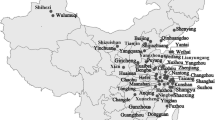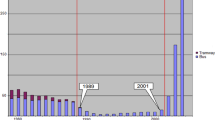Abstract
The bicycle sharing systems (BSSs) have been deployed extensively in Chinese cities. Would bicycle sharing helps to mitigate vehicle emission in Chinese cities? In this study, we attempt to investigate this question by estimating the emission reduction due to BSSs based on the mode shifts analysis in two largest cities in China, Beijing and Shanghai. The characteristics of the bikesharing trips are extracted from sample Mobike data. In order to examine whether the dockless BSSs can promote the transit ridership, the Difference-in-Difference (DID) analysis was conducted using the big data for BSSs and transit trips in Shanghai. The aggregated changes in mode shares suggest that BSSs in Beijing had a more significant impact on other modes, especially car trips, than the counterparts in Shanghai. However, the Mobike sample trips for Beijing was mostly very short in distance, which indicates most BSSs trips were unlikely to directly substitute car trips if not accounting for the changes in destination choices. Although BSSs provides an alternative connection option for urban transit system, the result of DID analysis shows the large scale deployment of the dockless BSSs in Shanghai hadn’t appeared to evidently stimulate the usage of the metro system. This finding doesn’t support the claim that BSSs could contribute to the emission reduction by complementing urban transit system. More empirical studies are needed in order to assist policy makers to perform more neutral assessment when regulating, subsidizing BSSs or integrating BSSs with other transit systems and policies.




Similar content being viewed by others
Notes
Chinese large cities refer to those Chinese cities with urbanized population over 5 million, according to the “National Plan on New Urbanization (2014–2020)” published by the State Council.
Using the CNY-USD exchange rate (1CNY = 0.14323USD) on Dec.31,2019.
In the end of 2017, the total number of dockless shared bicycles deployed in Beijing reached 2.2 million (the Beijing Transportation Institute 2018).
In the end of 2018, the total number of dockless shared bicycles deployed in Beijing reduced to 1.91 million (the Beijing Transportation Institute 2019).
References
Bejarano, M., Ceballos, L.M., Maya, J.: A user-centred assessment of a new bicycle sharing system in Medellin. Transp. Res. Part F Traffic Psychol. Behav. 44, 145–158 (2017)
Brons, M., Givoni, M., Rietveld, P.: Access to railway stations and its potential in increasing rail use. Transp. Res. Part A Policy Pract. 43(2), 136–149 (2009)
Campbell, K.B., Brakewood, C.: Sharing riders: How bikesharing impacts bus ridership in New York City. Transp. Res. Part A Policy Pract. 100, 264–282 (2017)
Cao, Y., Shen, D.: Contribution of shared bikes to carbon dioxide emission reduction and the economy in Beijing. Sustain. Cities Soc. 51, 101749 (2019)
Chen, Z., van Lierop, D., Ettema, D.: Dockless bike-sharing systems: what are the implications? Transp. Rev. 40(3), 333–353 (2020)
Economy, E.: Environmental governance in China: state control to crisis management. Daedalus 143(2), 184–197 (2014)
Enda, M., Joe, U.: The role of bicycle-sharing in the city: analysis of the irish experience. Int. J. Sustain. Transp. 9(2), 116–125 (2015)
Fishman, E., Washington, S., Haworth, N., et al.: Barriers to bikesharing: an analysis from Melbourne and Brisbane. J. Transp. Geogr. 41, 325–337 (2014a)
Fishman, E., Washington, S., Haworth, N.: Bike share: a synthesis of the literature. Transp. Rev. 33(2), 148–165 (2014b)
Fishman, E., Washington, S., Haworth, N., et al.: Factors influencing bike share membership: an analysis of Melbourne and Brisbane. Transp. Res. Part A 71, 17–30 (2015)
Goodman, A., Cheshire, J.: Inequalities in the London bicycle sharing system revisited: impacts of extending the scheme to poorer areas but then doubling prices. J. Transp. Geogr. 41(2), 272–279 (2014)
Gu, T., Kim, I., Currie, G.: Measuring immediate impacts of a new mass transit system on an existing bikeshare system in China. Trans. Res. Part A policy Pract. 124, 20–39 (2019)
Hamilton, T.L., Wichman, C.J.: Bicycle infrastructure and traffic congestion: evidence from DC’s capital Bikeshare. J. Environ. Econ. Manag. 87, 72–93 (2018)
Hang, Y.Z., Sun, J.: Investigating “Bicycle + Rail Transit” oriented urban space development: a case of Shanghai. Traffic Transp. 34(05), 6–9 (2018). (in Chinese)
Jia, Y., Fu, H.: Association between innovative dockless bicycle sharing programs and adopting cycling in commuting and non-commuting trips. Trans. Res. Part A Policy Pract. 121, 12–21 (2019)
Kou, Z., Wang, X., Chiu, S.F.A., Cai, H.: Quantifying greenhouse gas emissions reduction from bike share systems: a model considering real-world trips and transportation mode choice patterns. Resourc. Conserv. Recycl. 153, 104534 (2020)
Kulldorff, M.: A spatial scan statistic. Commun. Stat. Theory Methods 26(6), 1481–1496 (1997)
Kulldorff, M.: Prospective time periodic geographical disease surveillance using a scan statistic. J. R. Stat. Soc. A. Stat. Soc. 164(1), 61–72 (2001)
Li, C., Guo, J., An, Z., Hui, Z.: Comments on urban comprehensive transportation survey: learn lessons from the 5th beijing comprehensive transportation survey. Urban Transp. China 14(2), 29–34 (2016). (in Chinese)
Li, A., Zhao, P., Huang, Y., Gao, K., Axhausen, K.W.: An empirical analysis of dockless bike-sharing utilization and its explanatory factors: case study from Shanghai, China. J. Transp. Geogr. 88, 102828 (2020)
Li, A., Gao, K., Zhao, P., Qu, X., Axhausen, K.W.: High-resolution assessment of environmental benefits of dockless bike-sharing systems based on transaction data. J. Clean. Prod. 296, 126423 (2021)
Luo, H., Kou, Z., Zhao, F., Cai, H.: Comparative life cycle assessment of station-based and dock-less bike sharing systems. Resour. Conserv. Recycl. 146, 180–189 (2019)
Ma, X., Ji, Y., Yang, M., Jin, Y., Tan, X.: Understanding bikeshare mode as a feeder to metro by isolating metro-bikeshare transfers from smart card data. Transp. Policy 71, 57–69 (2018)
Ma, X., Zhang, X., Li, X., Wang, X., Zhao, X.: Impacts of free-floating bikesharing system on public transit ridership. Transp. Res. Part D Transp. Environ. 76, 100–110 (2019)
Ma, X., Yuan, Y., Van Oort, N., Hoogendoorn, S.: Bike-sharing systems’ impact on modal shift: a case study in Delft, the Netherlands. J. Clean. Prod. 120846 (2020)
Mao, G., Hou, T., Liu, X., Zuo, J., Kiyawa, A.H.I., Shi, P., Sandhu, S.: How can bicycle-sharing have a sustainable future? A research based on life cycle assessment. J. Clean. Prod. 282, 125081 (2020)
Martin, E.W., Shaheen, S.A.: Evaluating public transit modal shift dynamics in response to bikesharing: a tale of two US cities. J. Transp. Geogr. 41, 315–324 (2014)
Ministry of Housing and Urban-Rural Development of China: Guidelines on Enhancing the Development of Urban Walking and Bicycling Systems (2012). Accessible at http://www.mohurd.gov.cn/wjfb/201209/t20120917_211404.html (in Chinese), published on Sep 05, 2012, accessed on Dec 20, 2020.
Noland, R.B., Smart, M.J., Guo, Z.: Bikeshare trip generation in New York city. Transp. Res. Part A Policy Pract. 94, 164–181 (2016)
Pucher, J., Peng, Z.R., Mittal, N., Zhu, Y., Korattyswaroopam, N.: Urban transport trends and policies in china and india: impacts of rapid economic growth. Transp. Rev. 27(4), 379–410 (2007)
Qiu, L.Y., He, L.Y.: Bike sharing and the economy, the environment, and health-related externalities. Sustainability 10(4), 1145 (2018)
Tang, Y., Pan, H., Shen, Q.: Bike-sharing systems in Beijing, Shanghai, and Hangzhou and their impact on travel behavior. In: Transportation Research Board 90th Annual Meeting (2010)
The Transportation Committee of Beijing: The thirteen five-year transportation development planning in Beijing (2016). http://www.beijing.gov.cn/gongkai/guihua/wngh/sjzdzxgh/201907/t20190701_100237.html (in Chinese), Accessed on 29 Dec 2020
The Ministry of Ecology and Environment of China: Technical Guideline for the On-road Vehicle Air Pollution Emssion Inventory (2014). https://www.mee.gov.cn/gkml/hbb/bgg/201501/W020150107594587831090.pdf (in Chinese), Accessed on 29 Dec 2020
The Shanghai Urban and Rural Construction and Transportation Development Research Institute: The annual report of comprehensive urban transportation of Shanghai. Traffic Transp. 06, 10–12 (2018). (in Chinese)
Wang, M., Zhou, X.: Bike-sharing systems and congestion: evidence from US cities. J. Transp. Geogr. 65, 147–154 (2017)
Xing, Y., Wang, K., Lu, J.J.: Exploring travel patterns and trip purposes of dockless bike-sharing by analyzing massive bike-sharing data in Shanghai, China. J. Trans. Geography. 87, 102787 (2020)
Yang, J., Chen, J., Zhou, M., Wang, Z.: Major issues for biking revival in urban China. Habitat Int. 47, 176–182 (2015)
Zeng, Y., Cao, Y., Qiao, X., Seyler, B.C., Tang, Y.: Air pollution reduction in China: recent success but great challenge for the future. Sci. Total Environ. 663, 329–337 (2019)
Zhang, Y., Mi, Z.: Environmental benefits of bike sharing: a big data-based analysis. Appl. Energy 220, 296–301 (2018)
Zhang, M., Zhang, X., Wang, H.: Impact analysis of city scale on trip distance of urban residents. Manag. Sci. Eng. 4(04), 92 (2015)
Zhu, Y., Diao, M.: Understanding the spatiotemporal patterns of public bicycle usage: a case study of Hangzhou, China. Int. J. Sustain. Transp. 14(3), 163–176 (2020)
Zhu, W., Pang, Y., Wang, D., Timmermans, H.: Travel behavior change after the introduction of public bicycle systems: case study in Minhang District, Shanghai. In: Transportation Research Board 92nd Annual Meeting (No. 13-0764) (2013)
Acknowledgements
This research is funded by the Major Project of National Social Science Foundation of China [16ZDA048], and the Shanghai Philosophy and Social Science Program [2020BCK003].
Author information
Authors and Affiliations
Corresponding author
Additional information
Publisher's Note
Springer Nature remains neutral with regard to jurisdictional claims in published maps and institutional affiliations.
Rights and permissions
About this article
Cite this article
Zhu, Y. Can bicycle sharing mitigate vehicle emission in Chinese large cities? Estimation based on mode shift analysis. Transportation 49, 1627–1648 (2022). https://doi.org/10.1007/s11116-021-10222-3
Accepted:
Published:
Issue Date:
DOI: https://doi.org/10.1007/s11116-021-10222-3




